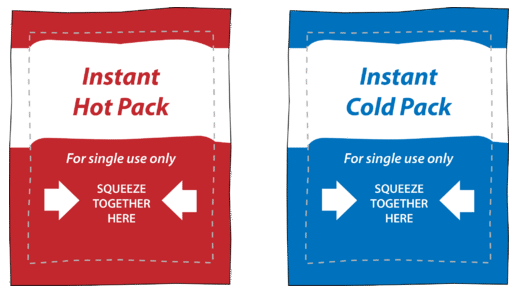17.13: Heat of Solution
- Page ID
- 53881
\( \newcommand{\vecs}[1]{\overset { \scriptstyle \rightharpoonup} {\mathbf{#1}} } \)
\( \newcommand{\vecd}[1]{\overset{-\!-\!\rightharpoonup}{\vphantom{a}\smash {#1}}} \)
\( \newcommand{\dsum}{\displaystyle\sum\limits} \)
\( \newcommand{\dint}{\displaystyle\int\limits} \)
\( \newcommand{\dlim}{\displaystyle\lim\limits} \)
\( \newcommand{\id}{\mathrm{id}}\) \( \newcommand{\Span}{\mathrm{span}}\)
( \newcommand{\kernel}{\mathrm{null}\,}\) \( \newcommand{\range}{\mathrm{range}\,}\)
\( \newcommand{\RealPart}{\mathrm{Re}}\) \( \newcommand{\ImaginaryPart}{\mathrm{Im}}\)
\( \newcommand{\Argument}{\mathrm{Arg}}\) \( \newcommand{\norm}[1]{\| #1 \|}\)
\( \newcommand{\inner}[2]{\langle #1, #2 \rangle}\)
\( \newcommand{\Span}{\mathrm{span}}\)
\( \newcommand{\id}{\mathrm{id}}\)
\( \newcommand{\Span}{\mathrm{span}}\)
\( \newcommand{\kernel}{\mathrm{null}\,}\)
\( \newcommand{\range}{\mathrm{range}\,}\)
\( \newcommand{\RealPart}{\mathrm{Re}}\)
\( \newcommand{\ImaginaryPart}{\mathrm{Im}}\)
\( \newcommand{\Argument}{\mathrm{Arg}}\)
\( \newcommand{\norm}[1]{\| #1 \|}\)
\( \newcommand{\inner}[2]{\langle #1, #2 \rangle}\)
\( \newcommand{\Span}{\mathrm{span}}\) \( \newcommand{\AA}{\unicode[.8,0]{x212B}}\)
\( \newcommand{\vectorA}[1]{\vec{#1}} % arrow\)
\( \newcommand{\vectorAt}[1]{\vec{\text{#1}}} % arrow\)
\( \newcommand{\vectorB}[1]{\overset { \scriptstyle \rightharpoonup} {\mathbf{#1}} } \)
\( \newcommand{\vectorC}[1]{\textbf{#1}} \)
\( \newcommand{\vectorD}[1]{\overrightarrow{#1}} \)
\( \newcommand{\vectorDt}[1]{\overrightarrow{\text{#1}}} \)
\( \newcommand{\vectE}[1]{\overset{-\!-\!\rightharpoonup}{\vphantom{a}\smash{\mathbf {#1}}}} \)
\( \newcommand{\vecs}[1]{\overset { \scriptstyle \rightharpoonup} {\mathbf{#1}} } \)
\( \newcommand{\vecd}[1]{\overset{-\!-\!\rightharpoonup}{\vphantom{a}\smash {#1}}} \)
\(\newcommand{\avec}{\mathbf a}\) \(\newcommand{\bvec}{\mathbf b}\) \(\newcommand{\cvec}{\mathbf c}\) \(\newcommand{\dvec}{\mathbf d}\) \(\newcommand{\dtil}{\widetilde{\mathbf d}}\) \(\newcommand{\evec}{\mathbf e}\) \(\newcommand{\fvec}{\mathbf f}\) \(\newcommand{\nvec}{\mathbf n}\) \(\newcommand{\pvec}{\mathbf p}\) \(\newcommand{\qvec}{\mathbf q}\) \(\newcommand{\svec}{\mathbf s}\) \(\newcommand{\tvec}{\mathbf t}\) \(\newcommand{\uvec}{\mathbf u}\) \(\newcommand{\vvec}{\mathbf v}\) \(\newcommand{\wvec}{\mathbf w}\) \(\newcommand{\xvec}{\mathbf x}\) \(\newcommand{\yvec}{\mathbf y}\) \(\newcommand{\zvec}{\mathbf z}\) \(\newcommand{\rvec}{\mathbf r}\) \(\newcommand{\mvec}{\mathbf m}\) \(\newcommand{\zerovec}{\mathbf 0}\) \(\newcommand{\onevec}{\mathbf 1}\) \(\newcommand{\real}{\mathbb R}\) \(\newcommand{\twovec}[2]{\left[\begin{array}{r}#1 \\ #2 \end{array}\right]}\) \(\newcommand{\ctwovec}[2]{\left[\begin{array}{c}#1 \\ #2 \end{array}\right]}\) \(\newcommand{\threevec}[3]{\left[\begin{array}{r}#1 \\ #2 \\ #3 \end{array}\right]}\) \(\newcommand{\cthreevec}[3]{\left[\begin{array}{c}#1 \\ #2 \\ #3 \end{array}\right]}\) \(\newcommand{\fourvec}[4]{\left[\begin{array}{r}#1 \\ #2 \\ #3 \\ #4 \end{array}\right]}\) \(\newcommand{\cfourvec}[4]{\left[\begin{array}{c}#1 \\ #2 \\ #3 \\ #4 \end{array}\right]}\) \(\newcommand{\fivevec}[5]{\left[\begin{array}{r}#1 \\ #2 \\ #3 \\ #4 \\ #5 \\ \end{array}\right]}\) \(\newcommand{\cfivevec}[5]{\left[\begin{array}{c}#1 \\ #2 \\ #3 \\ #4 \\ #5 \\ \end{array}\right]}\) \(\newcommand{\mattwo}[4]{\left[\begin{array}{rr}#1 \amp #2 \\ #3 \amp #4 \\ \end{array}\right]}\) \(\newcommand{\laspan}[1]{\text{Span}\{#1\}}\) \(\newcommand{\bcal}{\cal B}\) \(\newcommand{\ccal}{\cal C}\) \(\newcommand{\scal}{\cal S}\) \(\newcommand{\wcal}{\cal W}\) \(\newcommand{\ecal}{\cal E}\) \(\newcommand{\coords}[2]{\left\{#1\right\}_{#2}}\) \(\newcommand{\gray}[1]{\color{gray}{#1}}\) \(\newcommand{\lgray}[1]{\color{lightgray}{#1}}\) \(\newcommand{\rank}{\operatorname{rank}}\) \(\newcommand{\row}{\text{Row}}\) \(\newcommand{\col}{\text{Col}}\) \(\renewcommand{\row}{\text{Row}}\) \(\newcommand{\nul}{\text{Nul}}\) \(\newcommand{\var}{\text{Var}}\) \(\newcommand{\corr}{\text{corr}}\) \(\newcommand{\len}[1]{\left|#1\right|}\) \(\newcommand{\bbar}{\overline{\bvec}}\) \(\newcommand{\bhat}{\widehat{\bvec}}\) \(\newcommand{\bperp}{\bvec^\perp}\) \(\newcommand{\xhat}{\widehat{\xvec}}\) \(\newcommand{\vhat}{\widehat{\vvec}}\) \(\newcommand{\uhat}{\widehat{\uvec}}\) \(\newcommand{\what}{\widehat{\wvec}}\) \(\newcommand{\Sighat}{\widehat{\Sigma}}\) \(\newcommand{\lt}{<}\) \(\newcommand{\gt}{>}\) \(\newcommand{\amp}{&}\) \(\definecolor{fillinmathshade}{gray}{0.9}\)When preparing dilutions of concentrated sulfuric acid, the directions usually call for adding the acid slowly to water with frequent stirring. When this acid is mixed with water, a great deal of heat is released in the dissolution process. If water were added to acid, the water would quickly heat and splatter, causing harm to the person making the solution.
Heat of Solution
Enthalpy changes also occur when a solute undergoes the physical process of dissolving into a solvent. Hot packs and cold packs (see figure below) use this property. Many hot packs use calcium chloride, which releases heat when it dissolves, according to the equation below.
\[\ce{CaCl_2} \left (s \right) \rightarrow \ce{Ca^{2+}} \left( aq \right) + 2 \ce{Cl^-} \left( aq \right) + 82.8 \: \text{kJ}\nonumber \]
The molar heat of solution \(\left( \Delta H_\text{soln} \right)\) of a substance is the heat absorbed or released when one mole of the substance is dissolved in water. For calcium chloride, \(\Delta H_\text{soln} = -82.8 \: \text{kJ/mol}\).

Many cold packs use ammonium nitrate, which absorbs heat from the surroundings when it dissolves.
\[\ce{NH_4NO_3} \left( s \right) + 25.7 \: \text{kJ} \rightarrow \ce{NH_4^+} \left( aq \right) + \ce{NO_3^-} \left( aq \right)\nonumber \]
Cold packs are typically used to treat muscle strains and sore joints. The cold pack is activated and applied to the affected area. As the ammonium nitrate dissolves, it absorbs heat from the body and helps to limit swelling. For ammonium nitrate, \(\Delta H_\text{soln} = 25.7 \: \text{kJ/mol}\).
Example \(\PageIndex{1}\)
The molar heat of solution, \(\Delta H_\text{soln}\), of \(\ce{NaOH}\) is \(-44.51 \: \text{kJ/mol}\). In a certain experiment, \(50.0 \: \text{g}\) of \(\ce{NaOH}\) is completely dissolved in \(1.000 \: \text{L}\) of \(20.0^\text{o} \text{C}\) water in a foam cup calorimeter. Assuming no heat loss, calculate the final temperature of the water.
Solution
Step 1: List the known quantities and plan the problem.
Known
- Mass \(\ce{NaOH} = 50.0 \: \text{g}\)
- Molar mass \(\ce{NaOH} = 40.00 \: \text{g/mol}\)
- \(\Delta H_\text{soln} \: \left( \ce{NaOH} \right) = -44.51 \: \text{kJ/mol}\)
- Mass \(\ce{H_2O} = 1.000 \: \text{kg} = 1000. \: \text{g}\) (assumes density \(= 1.00 \: \text{g/mL}\))
- \(T_\text{initial} \: \left( \ce{H_2O} \right) = 20.0^\text{o} \text{C}\)
- \(c_p \: \left( \ce{H_2O} \right) = 4.18 \: \text{J/g}^\text{o} \text{C}\)
Unknown
This is a multiple-step problem:
1) Grams \(\ce{NaOH}\) is converted to moles.
2) Moles is multiplied by the molar heat of solution.
3) The joules of heat released in the dissolution process is used with the specific heat equation and the total mass of the solution to calculate the \(\Delta T\).
4) The \(T_\text{final}\) is determined from \(\Delta T\).
Step 2: Solve.
\[50.0 \: \text{g} \: \ce{NaOH} \times \frac{1 \: \text{mol} \: \ce{NaOH}}{40.00 \: \text{g} \: \ce{NaOH}} \times \frac{-44.51 \: \text{kJ}}{1 \: \text{mol} \: \ce{NaOH}} \times \frac{1000 \: \text{J}}{1 \: \text{kJ}} = -5.56 \times 10^4 \: \text{J}\nonumber \]
\[\Delta T = \frac{\Delta H}{c_p \times m} = \frac{-5.56 \times 10^4 \: \text{J}}{4.18 \: \text{J/g}^\text{o} \text{C} \times 1050 \: \text{g}} = 13.2^\text{o} \text{C}\nonumber \]
\[T_\text{final} = 20.0^\text{o} \text{C} + 13.2^\text{o} \text{C} = 33.2^\text{o} \text{C}\nonumber \]
Step 3: Think about your result.
The dissolution process releases a large amount of heat, which causes the temperature of the solution to rise. Care must be taken when preparing concentrated solutions of sodium hydroxide, because of the large amounts of heat released.
Summary
- The molar heat of solution \(\left( \Delta H_\text{soln} \right)\) of a substance is the heat absorbed or released when one mole of the substance is dissolved in water.
- Sample calculations using molar heat of solution are given.

